IT Service Management Assignment: Key BPM Initiatives
VerifiedAdded on 2020/05/04
|7
|1468
|123
Homework Assignment
AI Summary
This document provides detailed solutions to an IT Service Management assignment, addressing key questions related to Business Process Management (BPM) initiatives at enterprise, business process, and implementation levels. It explores the advantages and disadvantages of adopting these initiatives, focusing on cost efficiency, business agility, and innovation. The assignment also covers the use of scorecard concepts for measuring functional and process performance, the value of ISO/IEC 20000 certification, and the concept of value streams within the IT4IT framework. Furthermore, the document clarifies the distinction between governance and management, and explains how COBIT 5 enables holistic IT governance, including the concept of goals cascade. The solutions provide a comprehensive understanding of IT service management principles and practices.
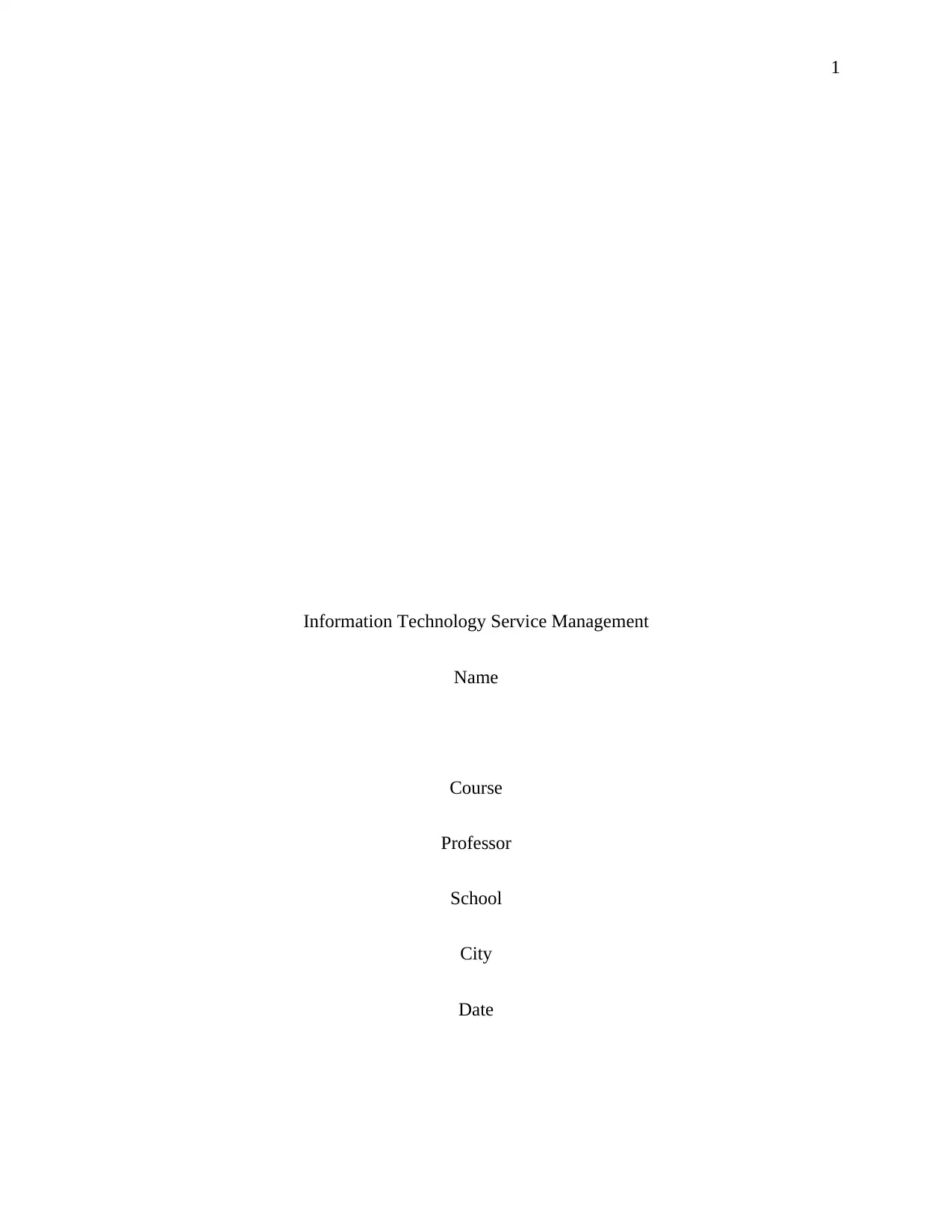
1
Information Technology Service Management
Name
Course
Professor
School
City
Date
Information Technology Service Management
Name
Course
Professor
School
City
Date
Paraphrase This Document
Need a fresh take? Get an instant paraphrase of this document with our AI Paraphraser
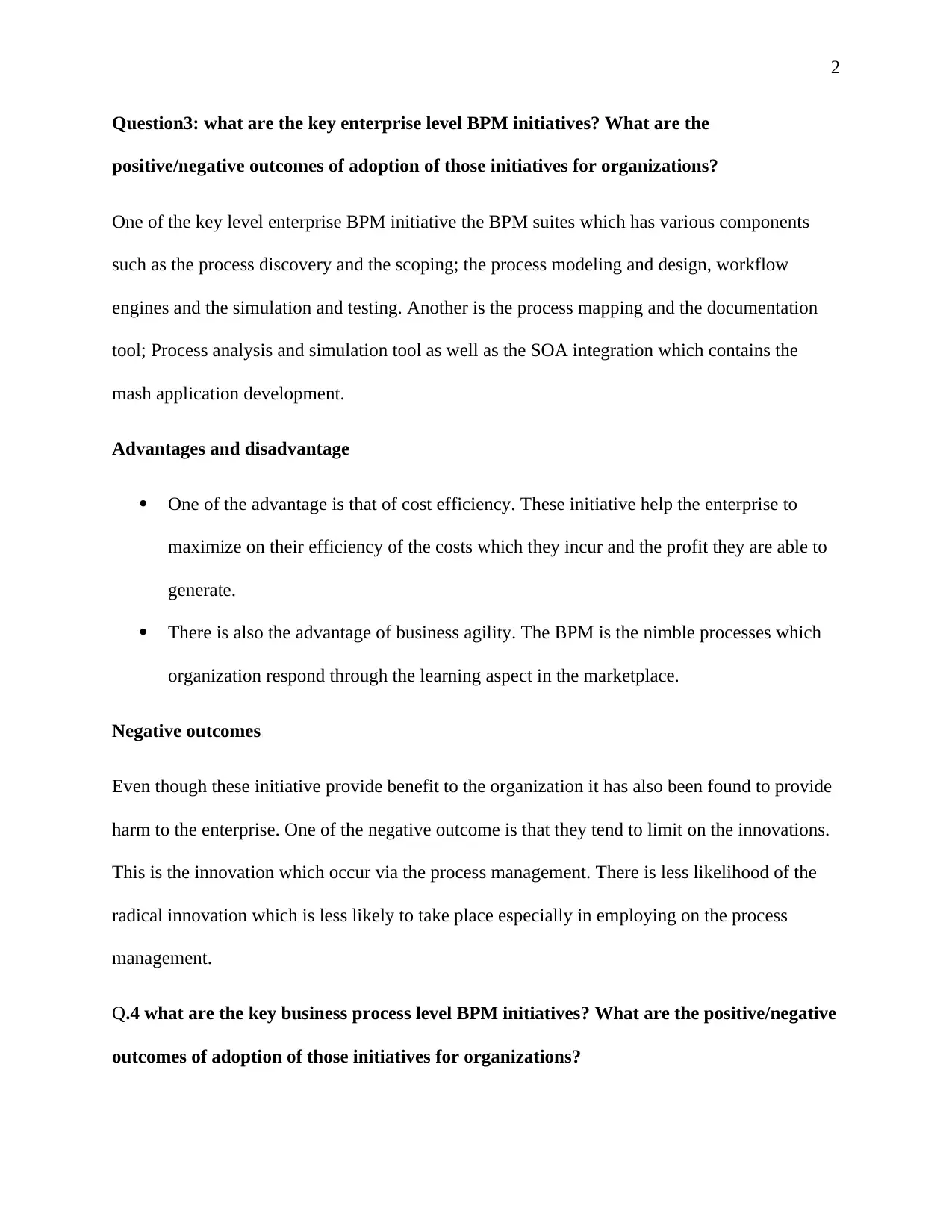
2
Question3: what are the key enterprise level BPM initiatives? What are the
positive/negative outcomes of adoption of those initiatives for organizations?
One of the key level enterprise BPM initiative the BPM suites which has various components
such as the process discovery and the scoping; the process modeling and design, workflow
engines and the simulation and testing. Another is the process mapping and the documentation
tool; Process analysis and simulation tool as well as the SOA integration which contains the
mash application development.
Advantages and disadvantage
One of the advantage is that of cost efficiency. These initiative help the enterprise to
maximize on their efficiency of the costs which they incur and the profit they are able to
generate.
There is also the advantage of business agility. The BPM is the nimble processes which
organization respond through the learning aspect in the marketplace.
Negative outcomes
Even though these initiative provide benefit to the organization it has also been found to provide
harm to the enterprise. One of the negative outcome is that they tend to limit on the innovations.
This is the innovation which occur via the process management. There is less likelihood of the
radical innovation which is less likely to take place especially in employing on the process
management.
Q.4 what are the key business process level BPM initiatives? What are the positive/negative
outcomes of adoption of those initiatives for organizations?
Question3: what are the key enterprise level BPM initiatives? What are the
positive/negative outcomes of adoption of those initiatives for organizations?
One of the key level enterprise BPM initiative the BPM suites which has various components
such as the process discovery and the scoping; the process modeling and design, workflow
engines and the simulation and testing. Another is the process mapping and the documentation
tool; Process analysis and simulation tool as well as the SOA integration which contains the
mash application development.
Advantages and disadvantage
One of the advantage is that of cost efficiency. These initiative help the enterprise to
maximize on their efficiency of the costs which they incur and the profit they are able to
generate.
There is also the advantage of business agility. The BPM is the nimble processes which
organization respond through the learning aspect in the marketplace.
Negative outcomes
Even though these initiative provide benefit to the organization it has also been found to provide
harm to the enterprise. One of the negative outcome is that they tend to limit on the innovations.
This is the innovation which occur via the process management. There is less likelihood of the
radical innovation which is less likely to take place especially in employing on the process
management.
Q.4 what are the key business process level BPM initiatives? What are the positive/negative
outcomes of adoption of those initiatives for organizations?
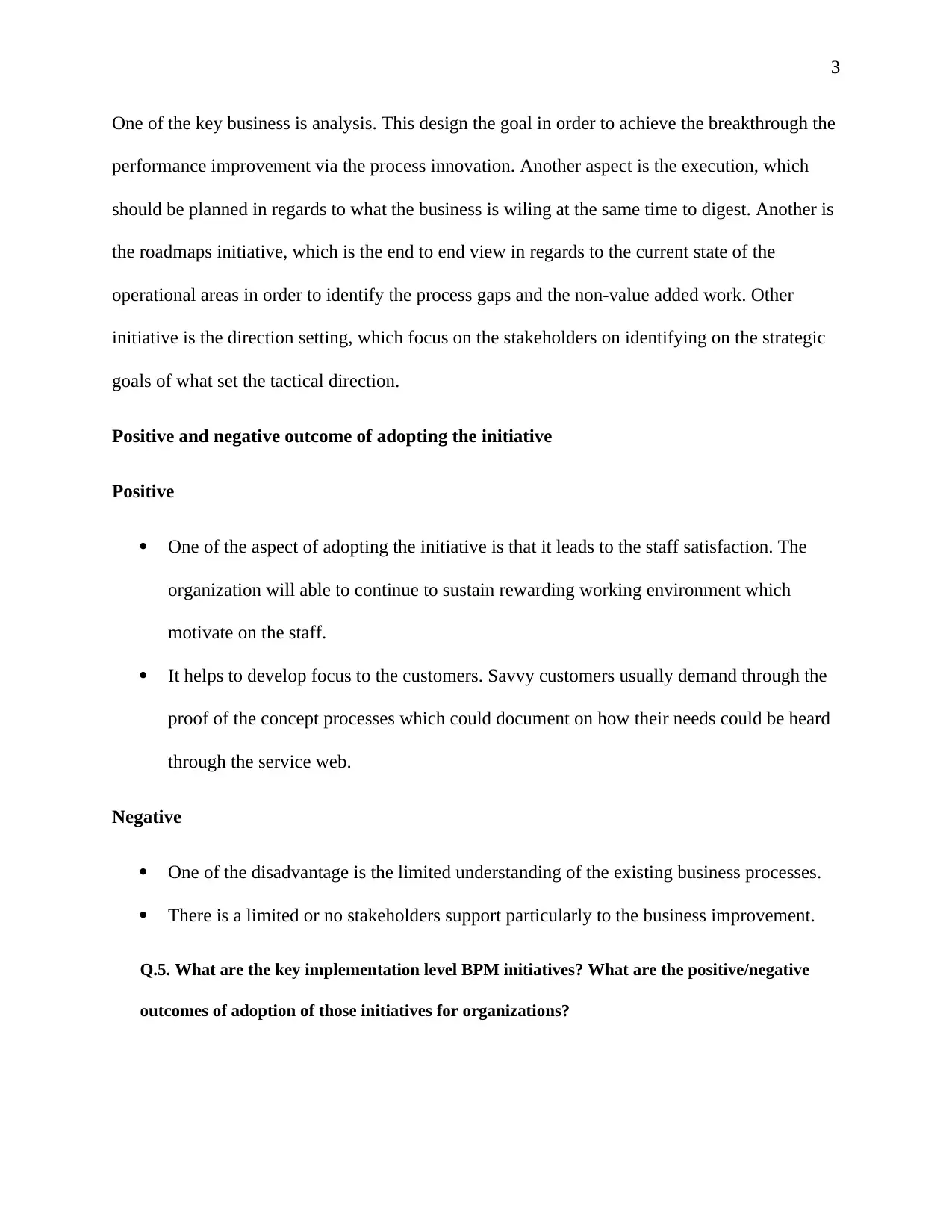
3
One of the key business is analysis. This design the goal in order to achieve the breakthrough the
performance improvement via the process innovation. Another aspect is the execution, which
should be planned in regards to what the business is wiling at the same time to digest. Another is
the roadmaps initiative, which is the end to end view in regards to the current state of the
operational areas in order to identify the process gaps and the non-value added work. Other
initiative is the direction setting, which focus on the stakeholders on identifying on the strategic
goals of what set the tactical direction.
Positive and negative outcome of adopting the initiative
Positive
One of the aspect of adopting the initiative is that it leads to the staff satisfaction. The
organization will able to continue to sustain rewarding working environment which
motivate on the staff.
It helps to develop focus to the customers. Savvy customers usually demand through the
proof of the concept processes which could document on how their needs could be heard
through the service web.
Negative
One of the disadvantage is the limited understanding of the existing business processes.
There is a limited or no stakeholders support particularly to the business improvement.
Q.5. What are the key implementation level BPM initiatives? What are the positive/negative
outcomes of adoption of those initiatives for organizations?
One of the key business is analysis. This design the goal in order to achieve the breakthrough the
performance improvement via the process innovation. Another aspect is the execution, which
should be planned in regards to what the business is wiling at the same time to digest. Another is
the roadmaps initiative, which is the end to end view in regards to the current state of the
operational areas in order to identify the process gaps and the non-value added work. Other
initiative is the direction setting, which focus on the stakeholders on identifying on the strategic
goals of what set the tactical direction.
Positive and negative outcome of adopting the initiative
Positive
One of the aspect of adopting the initiative is that it leads to the staff satisfaction. The
organization will able to continue to sustain rewarding working environment which
motivate on the staff.
It helps to develop focus to the customers. Savvy customers usually demand through the
proof of the concept processes which could document on how their needs could be heard
through the service web.
Negative
One of the disadvantage is the limited understanding of the existing business processes.
There is a limited or no stakeholders support particularly to the business improvement.
Q.5. What are the key implementation level BPM initiatives? What are the positive/negative
outcomes of adoption of those initiatives for organizations?
⊘ This is a preview!⊘
Do you want full access?
Subscribe today to unlock all pages.

Trusted by 1+ million students worldwide
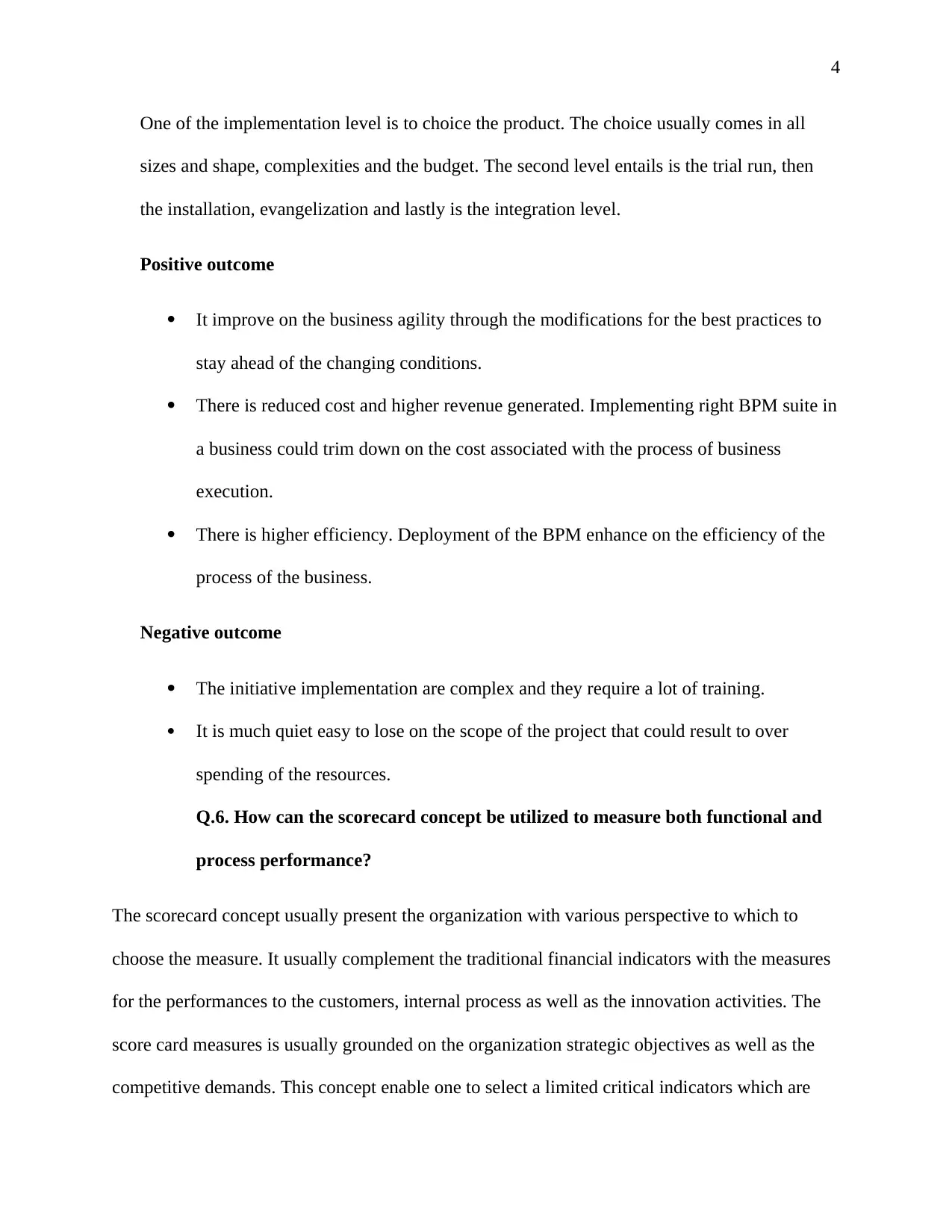
4
One of the implementation level is to choice the product. The choice usually comes in all
sizes and shape, complexities and the budget. The second level entails is the trial run, then
the installation, evangelization and lastly is the integration level.
Positive outcome
It improve on the business agility through the modifications for the best practices to
stay ahead of the changing conditions.
There is reduced cost and higher revenue generated. Implementing right BPM suite in
a business could trim down on the cost associated with the process of business
execution.
There is higher efficiency. Deployment of the BPM enhance on the efficiency of the
process of the business.
Negative outcome
The initiative implementation are complex and they require a lot of training.
It is much quiet easy to lose on the scope of the project that could result to over
spending of the resources.
Q.6. How can the scorecard concept be utilized to measure both functional and
process performance?
The scorecard concept usually present the organization with various perspective to which to
choose the measure. It usually complement the traditional financial indicators with the measures
for the performances to the customers, internal process as well as the innovation activities. The
score card measures is usually grounded on the organization strategic objectives as well as the
competitive demands. This concept enable one to select a limited critical indicators which are
One of the implementation level is to choice the product. The choice usually comes in all
sizes and shape, complexities and the budget. The second level entails is the trial run, then
the installation, evangelization and lastly is the integration level.
Positive outcome
It improve on the business agility through the modifications for the best practices to
stay ahead of the changing conditions.
There is reduced cost and higher revenue generated. Implementing right BPM suite in
a business could trim down on the cost associated with the process of business
execution.
There is higher efficiency. Deployment of the BPM enhance on the efficiency of the
process of the business.
Negative outcome
The initiative implementation are complex and they require a lot of training.
It is much quiet easy to lose on the scope of the project that could result to over
spending of the resources.
Q.6. How can the scorecard concept be utilized to measure both functional and
process performance?
The scorecard concept usually present the organization with various perspective to which to
choose the measure. It usually complement the traditional financial indicators with the measures
for the performances to the customers, internal process as well as the innovation activities. The
score card measures is usually grounded on the organization strategic objectives as well as the
competitive demands. This concept enable one to select a limited critical indicators which are
Paraphrase This Document
Need a fresh take? Get an instant paraphrase of this document with our AI Paraphraser
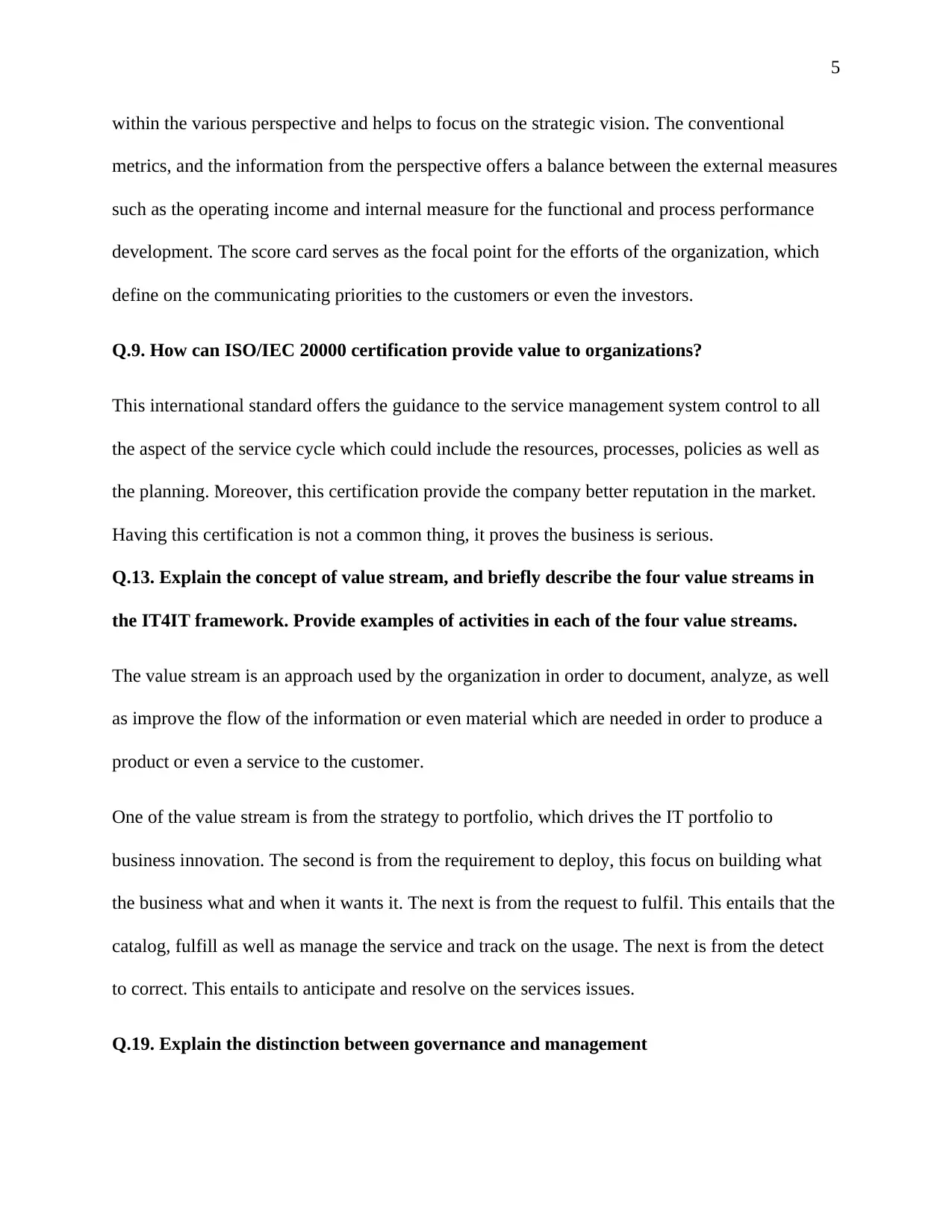
5
within the various perspective and helps to focus on the strategic vision. The conventional
metrics, and the information from the perspective offers a balance between the external measures
such as the operating income and internal measure for the functional and process performance
development. The score card serves as the focal point for the efforts of the organization, which
define on the communicating priorities to the customers or even the investors.
Q.9. How can ISO/IEC 20000 certification provide value to organizations?
This international standard offers the guidance to the service management system control to all
the aspect of the service cycle which could include the resources, processes, policies as well as
the planning. Moreover, this certification provide the company better reputation in the market.
Having this certification is not a common thing, it proves the business is serious.
Q.13. Explain the concept of value stream, and briefly describe the four value streams in
the IT4IT framework. Provide examples of activities in each of the four value streams.
The value stream is an approach used by the organization in order to document, analyze, as well
as improve the flow of the information or even material which are needed in order to produce a
product or even a service to the customer.
One of the value stream is from the strategy to portfolio, which drives the IT portfolio to
business innovation. The second is from the requirement to deploy, this focus on building what
the business what and when it wants it. The next is from the request to fulfil. This entails that the
catalog, fulfill as well as manage the service and track on the usage. The next is from the detect
to correct. This entails to anticipate and resolve on the services issues.
Q.19. Explain the distinction between governance and management
within the various perspective and helps to focus on the strategic vision. The conventional
metrics, and the information from the perspective offers a balance between the external measures
such as the operating income and internal measure for the functional and process performance
development. The score card serves as the focal point for the efforts of the organization, which
define on the communicating priorities to the customers or even the investors.
Q.9. How can ISO/IEC 20000 certification provide value to organizations?
This international standard offers the guidance to the service management system control to all
the aspect of the service cycle which could include the resources, processes, policies as well as
the planning. Moreover, this certification provide the company better reputation in the market.
Having this certification is not a common thing, it proves the business is serious.
Q.13. Explain the concept of value stream, and briefly describe the four value streams in
the IT4IT framework. Provide examples of activities in each of the four value streams.
The value stream is an approach used by the organization in order to document, analyze, as well
as improve the flow of the information or even material which are needed in order to produce a
product or even a service to the customer.
One of the value stream is from the strategy to portfolio, which drives the IT portfolio to
business innovation. The second is from the requirement to deploy, this focus on building what
the business what and when it wants it. The next is from the request to fulfil. This entails that the
catalog, fulfill as well as manage the service and track on the usage. The next is from the detect
to correct. This entails to anticipate and resolve on the services issues.
Q.19. Explain the distinction between governance and management
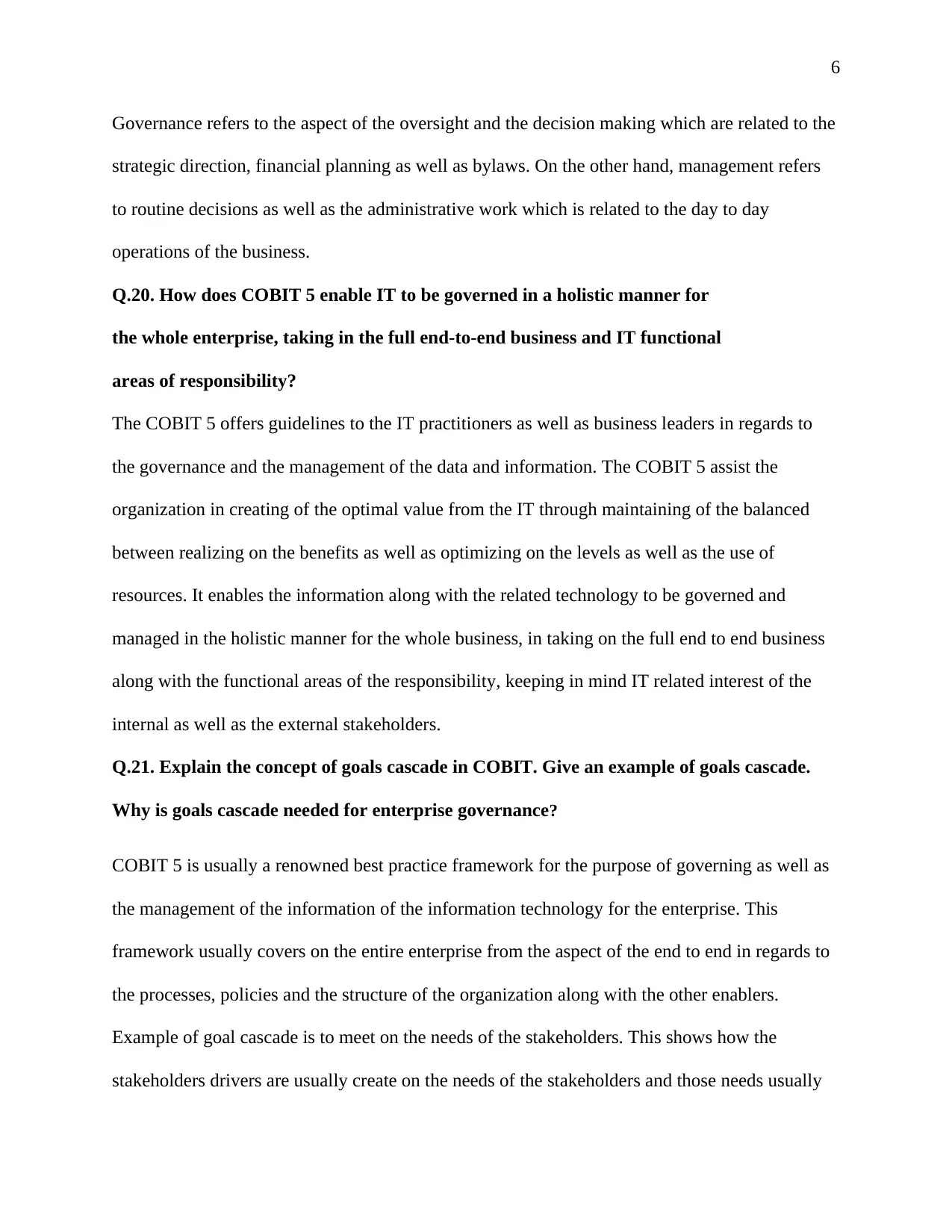
6
Governance refers to the aspect of the oversight and the decision making which are related to the
strategic direction, financial planning as well as bylaws. On the other hand, management refers
to routine decisions as well as the administrative work which is related to the day to day
operations of the business.
Q.20. How does COBIT 5 enable IT to be governed in a holistic manner for
the whole enterprise, taking in the full end-to-end business and IT functional
areas of responsibility?
The COBIT 5 offers guidelines to the IT practitioners as well as business leaders in regards to
the governance and the management of the data and information. The COBIT 5 assist the
organization in creating of the optimal value from the IT through maintaining of the balanced
between realizing on the benefits as well as optimizing on the levels as well as the use of
resources. It enables the information along with the related technology to be governed and
managed in the holistic manner for the whole business, in taking on the full end to end business
along with the functional areas of the responsibility, keeping in mind IT related interest of the
internal as well as the external stakeholders.
Q.21. Explain the concept of goals cascade in COBIT. Give an example of goals cascade.
Why is goals cascade needed for enterprise governance?
COBIT 5 is usually a renowned best practice framework for the purpose of governing as well as
the management of the information of the information technology for the enterprise. This
framework usually covers on the entire enterprise from the aspect of the end to end in regards to
the processes, policies and the structure of the organization along with the other enablers.
Example of goal cascade is to meet on the needs of the stakeholders. This shows how the
stakeholders drivers are usually create on the needs of the stakeholders and those needs usually
Governance refers to the aspect of the oversight and the decision making which are related to the
strategic direction, financial planning as well as bylaws. On the other hand, management refers
to routine decisions as well as the administrative work which is related to the day to day
operations of the business.
Q.20. How does COBIT 5 enable IT to be governed in a holistic manner for
the whole enterprise, taking in the full end-to-end business and IT functional
areas of responsibility?
The COBIT 5 offers guidelines to the IT practitioners as well as business leaders in regards to
the governance and the management of the data and information. The COBIT 5 assist the
organization in creating of the optimal value from the IT through maintaining of the balanced
between realizing on the benefits as well as optimizing on the levels as well as the use of
resources. It enables the information along with the related technology to be governed and
managed in the holistic manner for the whole business, in taking on the full end to end business
along with the functional areas of the responsibility, keeping in mind IT related interest of the
internal as well as the external stakeholders.
Q.21. Explain the concept of goals cascade in COBIT. Give an example of goals cascade.
Why is goals cascade needed for enterprise governance?
COBIT 5 is usually a renowned best practice framework for the purpose of governing as well as
the management of the information of the information technology for the enterprise. This
framework usually covers on the entire enterprise from the aspect of the end to end in regards to
the processes, policies and the structure of the organization along with the other enablers.
Example of goal cascade is to meet on the needs of the stakeholders. This shows how the
stakeholders drivers are usually create on the needs of the stakeholders and those needs usually
⊘ This is a preview!⊘
Do you want full access?
Subscribe today to unlock all pages.

Trusted by 1+ million students worldwide
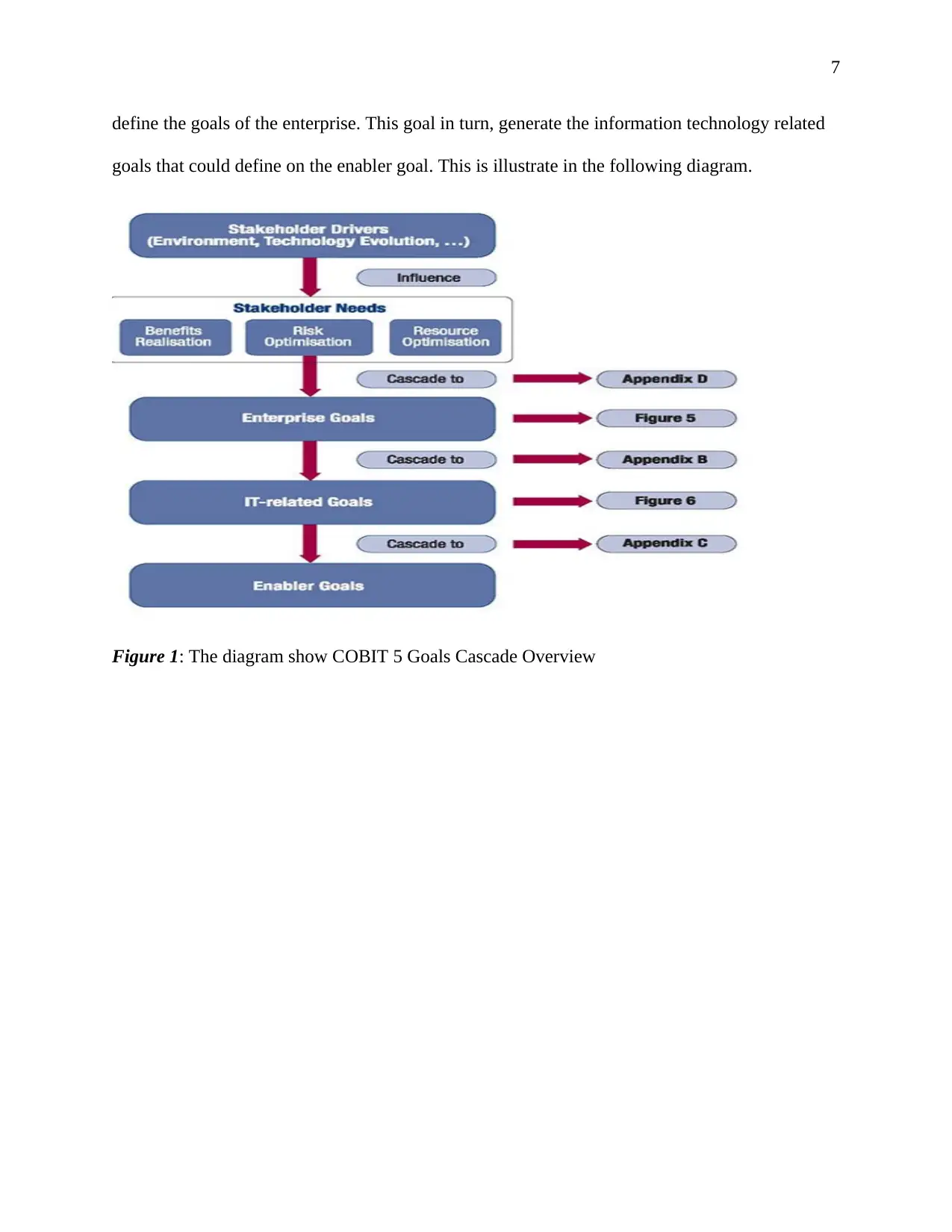
7
define the goals of the enterprise. This goal in turn, generate the information technology related
goals that could define on the enabler goal. This is illustrate in the following diagram.
Figure 1: The diagram show COBIT 5 Goals Cascade Overview
define the goals of the enterprise. This goal in turn, generate the information technology related
goals that could define on the enabler goal. This is illustrate in the following diagram.
Figure 1: The diagram show COBIT 5 Goals Cascade Overview
1 out of 7
Related Documents
Your All-in-One AI-Powered Toolkit for Academic Success.
+13062052269
info@desklib.com
Available 24*7 on WhatsApp / Email
![[object Object]](/_next/static/media/star-bottom.7253800d.svg)
Unlock your academic potential
Copyright © 2020–2025 A2Z Services. All Rights Reserved. Developed and managed by ZUCOL.





